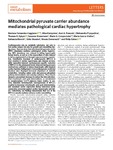Mitochondrial Pyruvate Carrier Abundance Mediates Pathological Cardiac Hypertrophy

Use este enlace para citar
http://hdl.handle.net/2183/27599Colecciones
- Investigación (FCS) [1293]
Metadatos
Mostrar el registro completo del ítemTítulo
Mitochondrial Pyruvate Carrier Abundance Mediates Pathological Cardiac HypertrophyAutor(es)
Fecha
2020-10-26Cita bibliográfica
Fernandez-Caggiano M, Kamynina A, Francois AA, et al. Mitochondrial pyruvate carrier abundance mediates pathological cardiac hypertrophy. Nat Metab. 2020; 2:1223–1231
Resumen
[Abstract]
Cardiomyocytes rely on metabolic substrates, not only to fuel cardiac output, but also for growth and remodelling during stress. Here we show that mitochondrial pyruvate carrier (MPC) abundance mediates pathological cardiac hypertrophy. MPC abundance was reduced in failing hypertrophic human hearts, as well as in the myocardium of mice induced to fail by angiotensin II or through transverse aortic constriction. Constitutive knockout of cardiomyocyte MPC1/2 in mice resulted in cardiac hypertrophy and reduced survival, while tamoxifen-induced cardiomyocyte-specific reduction of MPC1/2 to the attenuated levels observed during pressure overload was sufficient to induce hypertrophy with impaired cardiac function. Failing hearts from cardiomyocyte-restricted knockout mice displayed increased abundance of anabolic metabolites, including amino acids and pentose phosphate pathway intermediates and reducing cofactors. These hearts showed a concomitant decrease in carbon flux into mitochondrial tricarboxylic acid cycle intermediates, as corroborated by complementary 1,2-[13C2]glucose tracer studies. In contrast, inducible cardiomyocyte overexpression of MPC1/2 resulted in increased tricarboxylic acid cycle intermediates, and sustained carrier expression during transverse aortic constriction protected against cardiac hypertrophy and failure. Collectively, our findings demonstrate that loss of the MPC1/2 causally mediates adverse cardiac remodelling.
Versión del editor
Derechos
The final publication is avaliable at Springer Link
ISSN
2522-5812





